- Home
- Garden Wildlife
- Insects
- Lepidoptera
- Gregarious larvae
Moths with gregarious larvae
Some moths have caterpillars that stay together and feed as a family group throughout all or most of the larval period. Many cover their feeding area with silk webbing. Some sawflies, which are insects in the order Hymenoptera have caterpillar-like larvae that feed gregariously. Most sawfly larvae do not web their food plant and they have seven pairs of suckers or prolegs on their abdomen, whereas moth larvae have up to five pairs of prolegs. Be aware also that the small tortoiseshell butterfly Aglais urticae also has gregarious larvae on nettle.
Species in Britain and Ireland
Larger moths with gregarious larvae that are likely to be found on garden plants in Britain and Ireland include buff-tip moth, Phalera bucephala, lackey moth, Malacosoma neustria (when young), and brown-tail moth, Euproctis chrysorrhoea. All of these have caterpillars that feed on various deciduous trees and shrubs.
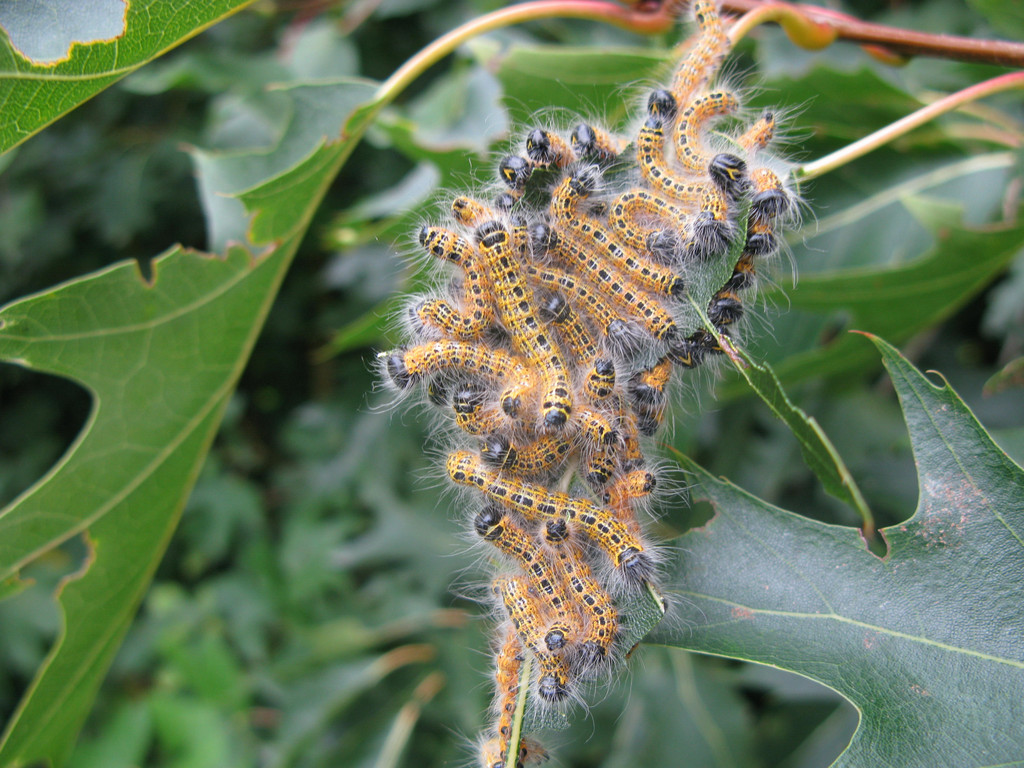
Above: communal web of many thousand spindle ermine caterpillars Yponomeuta cagnagella on roadside hawthorn, and two disturbed caterpillars, each hanging from a single silk thread.
Biology
After hatching, the larvae of these moths do not disperse but stay together and feed on foliage as a group. With the exception of the buff-tip and cinnabar moths, the larvae of these moths all spin silk webbing over their feeding area or create communal silk ‘nests’ in which they shelter when not feeding. Because the larvae feed together and may occur in large numbers, they are capable of defoliating small trees and shrubs.
Life cycle
Eggs are laid on the foliage or stems of plants that will provide suitable food for the larvae. After hatching the caterpillars feed on the foliage. When fully fed, the caterpillars either spin silk cocoons within the silk webbing on the food plant or they wander away from their food plants and go down into the soil where they pupate. During the pupal or chrysalis stage, the caterpillar’s tissues are broken down and rebuilt to produce the adult moth.
Some moths with gregarious larvae, such as box moth, hawthorn webber and some small ermine moths can have two generations a year. Depending on the species, these moths can overwinter as eggs, larvae or pupae.
Role of moths with gregarious larvae in gardens
The defoliation caused by gregarious moth larvae can be extensive but affected plants usually survive as long as this does not occur too frequently. Defoliation that occurs in late summer is of less consequence that similar damage in late spring-early summer.
Brown-tail moth and oak processionary moth are a problem in gardens because of the rash-inducing hairs on the caterpillars’ bodies. Other moths with hairy caterpillars can be found in gardens but they do not cause skin rashes. Hairy caterpillars and those that live within silk webbing are generally not eaten by birds, although they are attacked by various parasitic insects.
Other sources of information
Websites
Moth website of Butterfly Conservation
Website of UK Moths
Books
Goater, B. (1986) British Pyralid Moths. Harley Books
Porter, J. (2010) Colour Identification Guide to the Caterpillars of the British Isles. Apollo Books
Skinner, B. (2009) Colour Identification Guide to the Moths of the British Isles. Apollo Books
Sterling, P., Parsons, M. and Lewington R. (2018) Field Guide to the Micro-moths of Great Britain and Ireland. British Wildlife Publications
Sterling, P., Henwood, B., Lewington, R. (2020) Field Guide to the Caterpillars of Great Britain and Ireland
Bloomsbury Wildlife Guides
Townsend, M. Waring, P. and Lewington R. (2018) Concise Guide to the Moths of Great Britain and Ireland. British Wildlife Publication
Page drafted by Andrew Halstead reviewed by Andrew Salisbury edited by Steve Head
![Buff-tip Phalera bucephala Photo: By Ben Sale from UK - [1994] , CC BY 2.0, https://commons.wikimedia.org/w/index.php?curid=63708296](images/1024px-(1994)_Buff-tip_(Phalera_bucephala)_(34924490041).jpg)
Buff-tip moth, Phalera bucephala adult - camouflaged as a broken twig. Right: Gregarious caterpillars
![The Lackey Malacosoma neustria Photo: By Ben Sale from UK - [1634] , CC BY 2.0, https://commons.wikimedia.org/w/index.php?curid=63707568](images/(1634)_The_Lackey_(Malacosoma_neustria)_(28267552721).jpg)
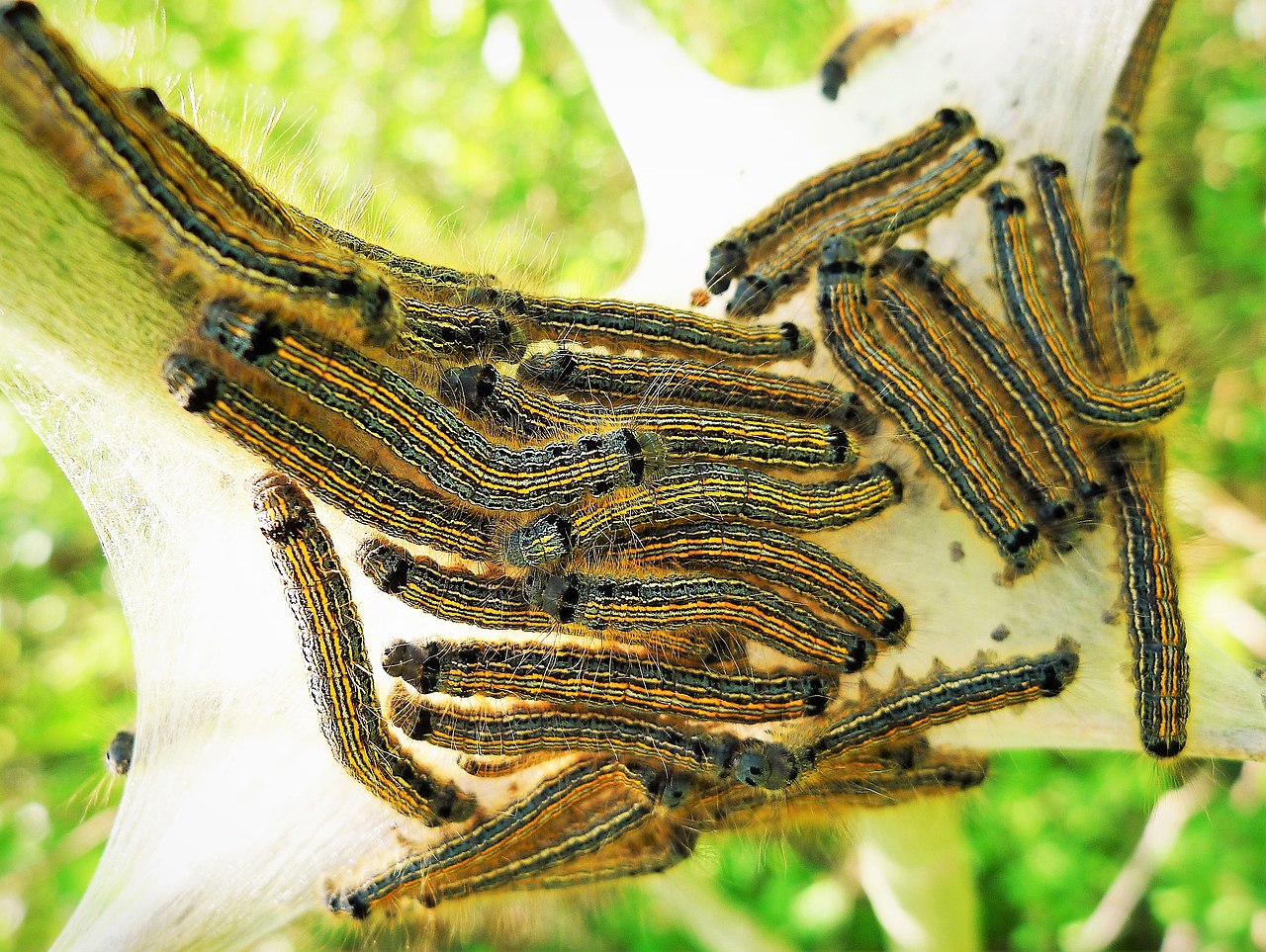
Lackey moth, Malacosoma neustria. Well camouflaged adult and gregarious caterpillars on willow
.jpg)
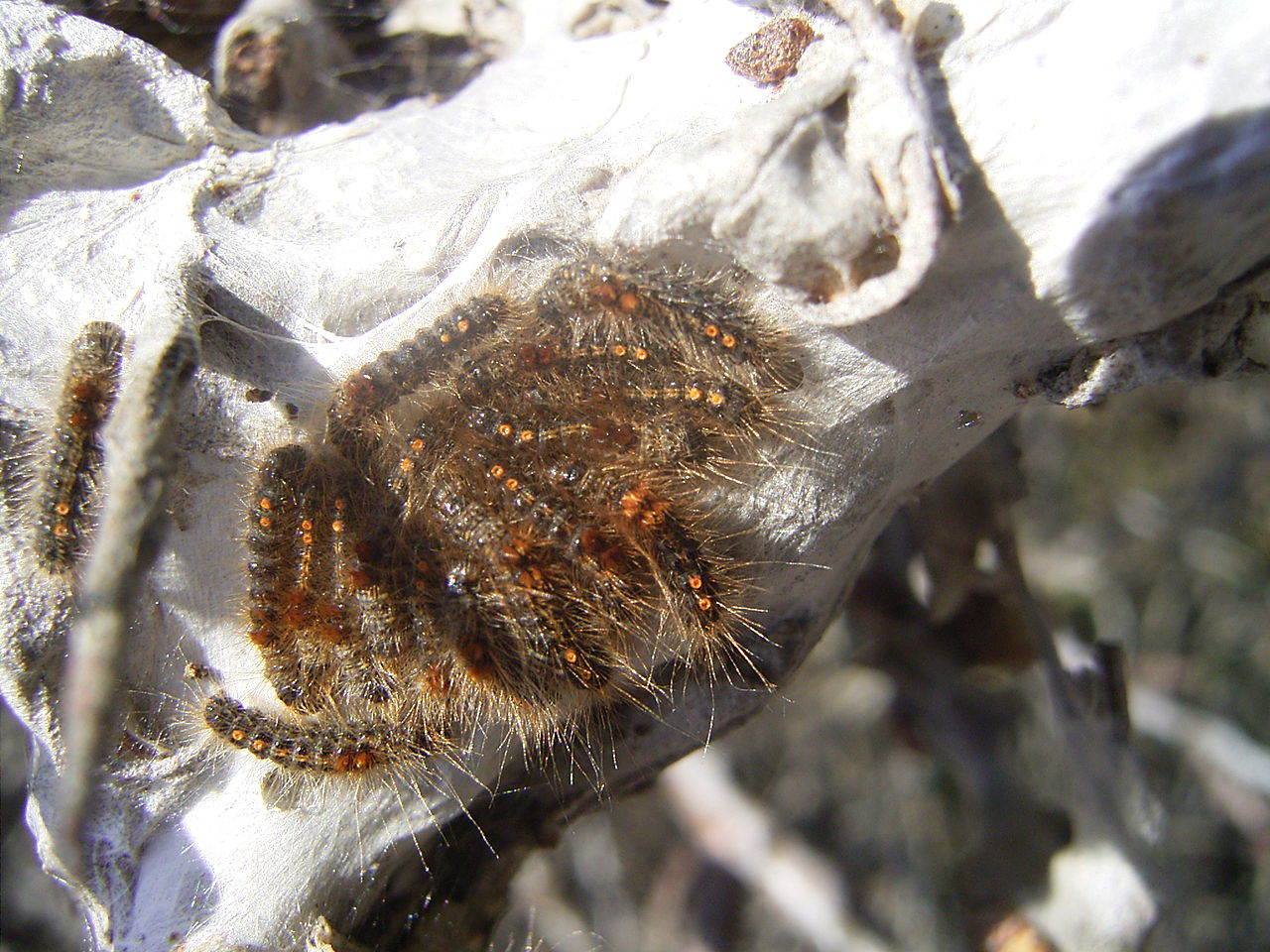
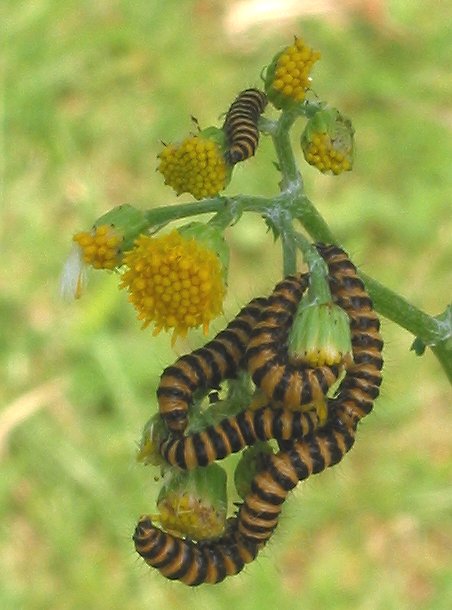
Brown-tail moth, Euproctis chrysorrhoea adult displaying and gregarious larvae in communal web
The day-flying cinnabar moth Tyria jacobaeae has extremely distinctive warning-coloured caterpillars which feed on ragwort Senecio jacobaea and are often found feeding in loose groups .
Two non-native species that have recently become established in Britain are the box moth, Diaphania perspectalis on box Buxus sempervirens and oak processionary moth, Thaumetopoea processionea, on oak, both of which are causing considerable concern. Caterpillars of the brown-tail moth and oak processionary moth have hairy bodies. The hairs readily break off and can cause a severe irritating skin rash on people through contact with the caterpillars, or from hairs carried on the wind. When oak processionary larvae leave their daytime shelters to feed on oak foliage, they follow each other head to tail, hence the ‘processionary’ name.
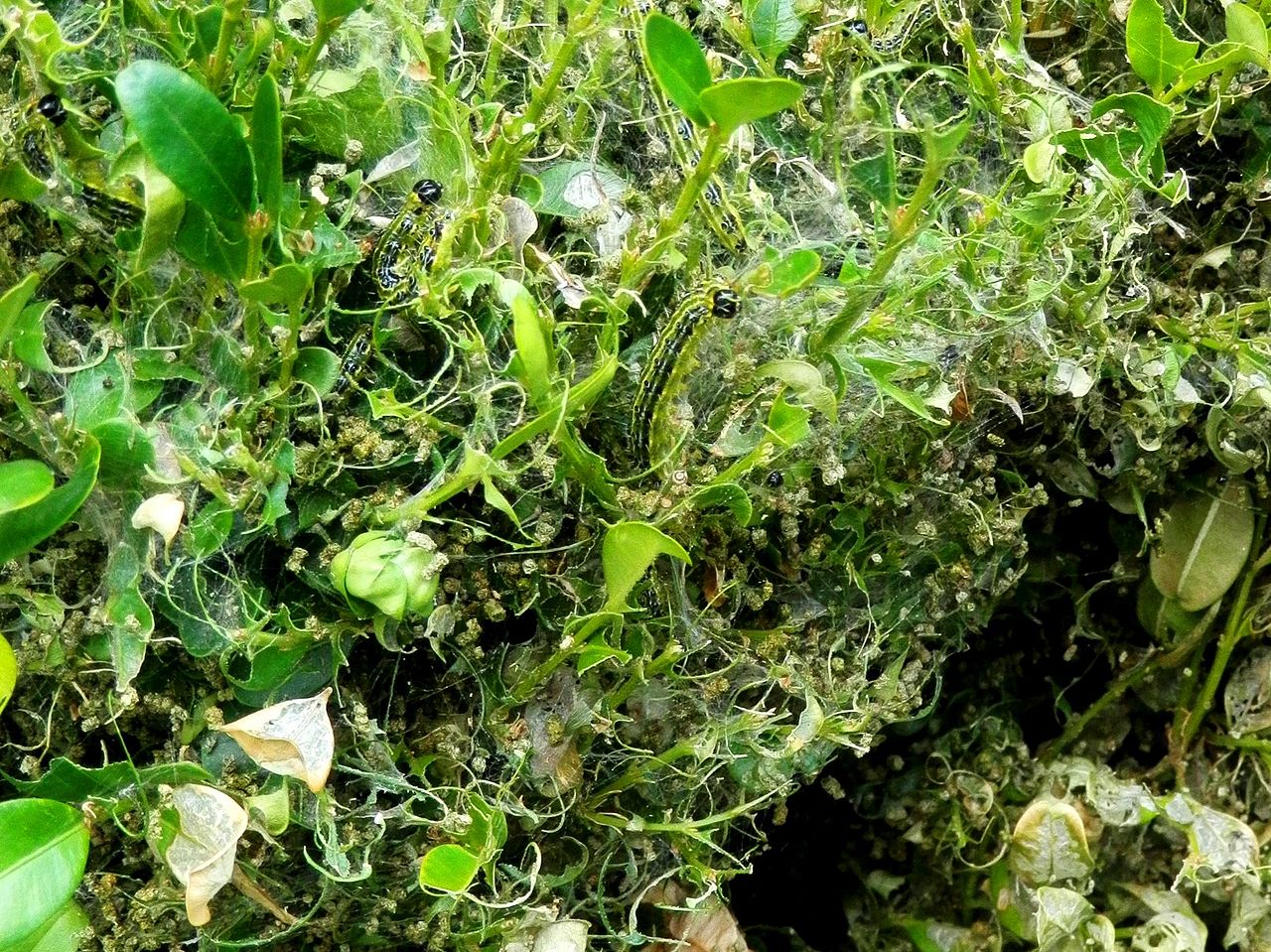
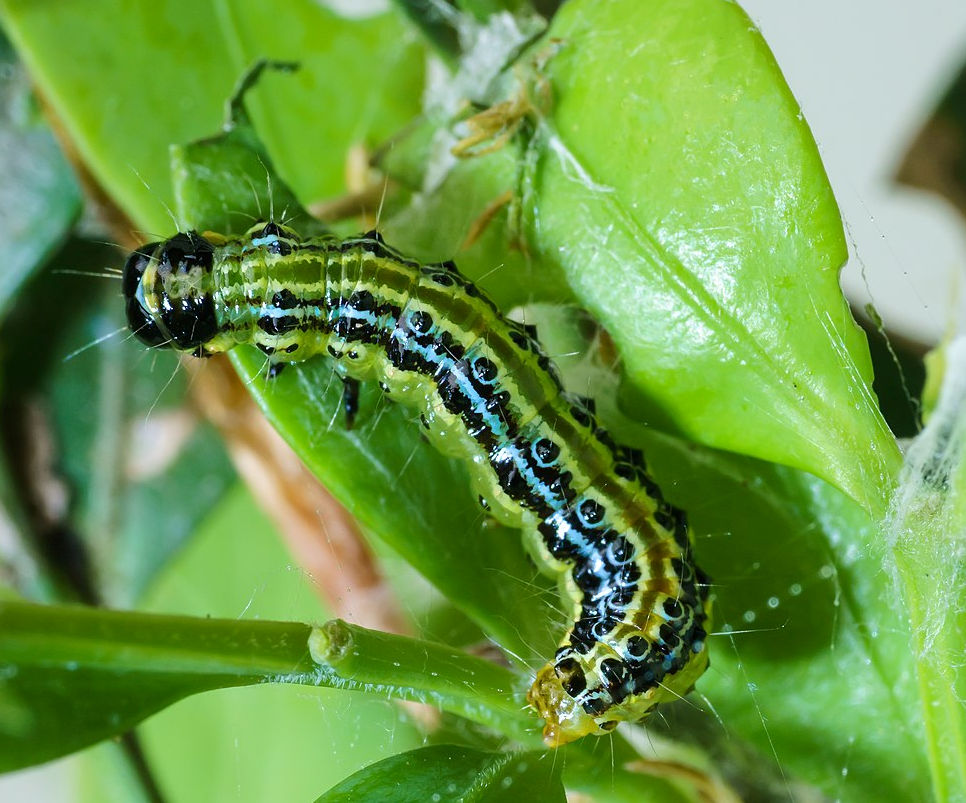
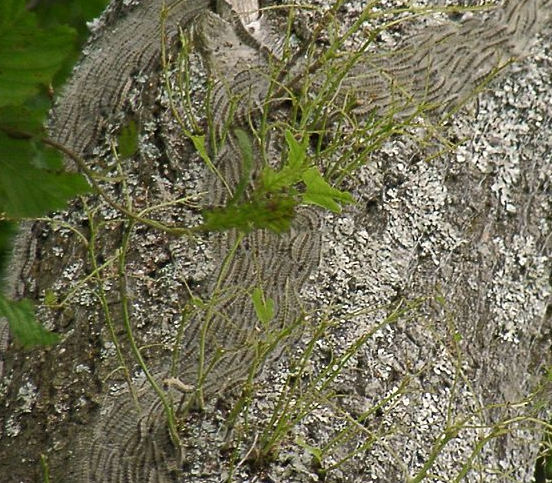
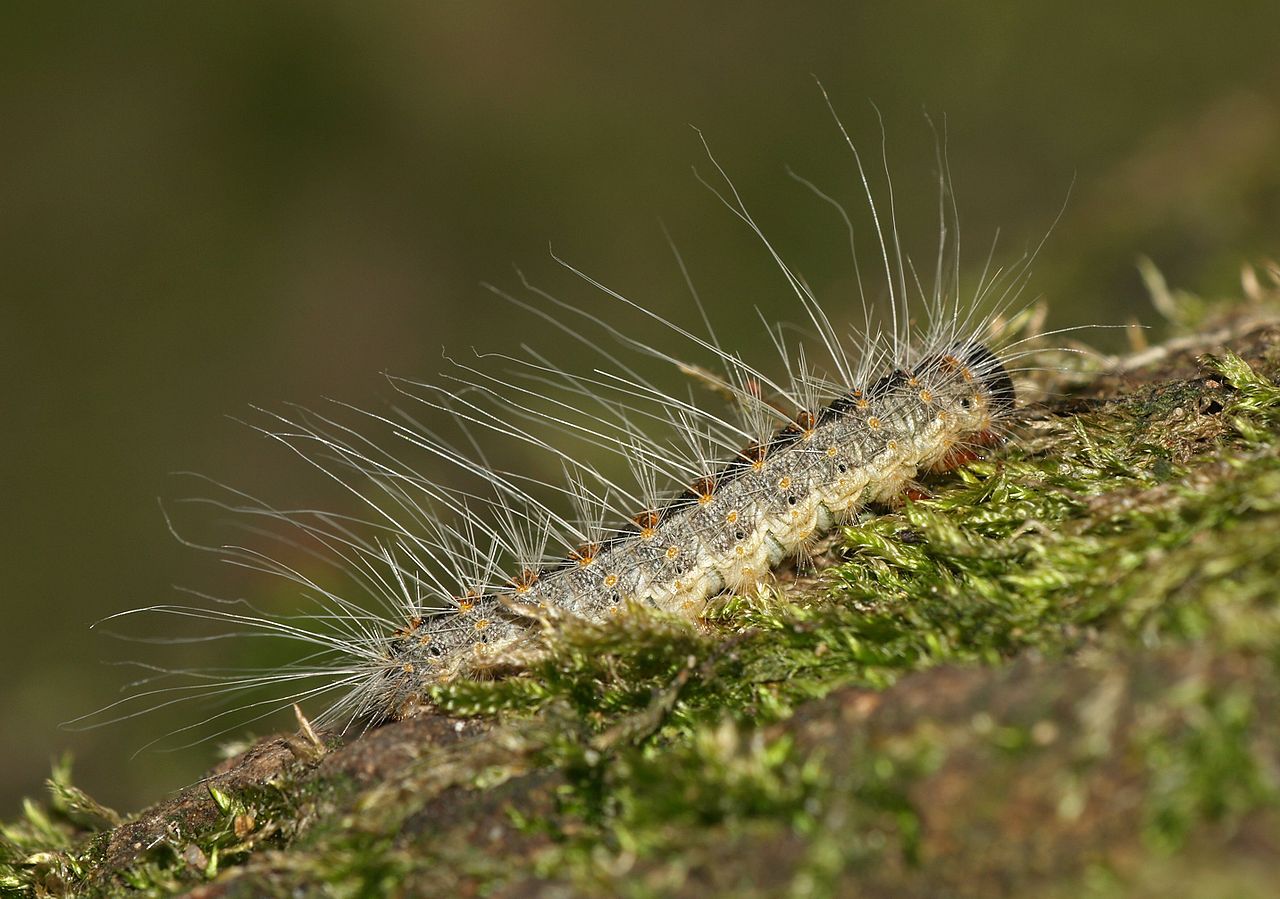
Box moth, Diaphania perspectalis caterpillar and communal defoliation effect
Oak processionary moth Thaumetopoea processionea, single caterpillar and several hundred "processing" on oak trunk.
Among the micro-moths with gregarious larvae are hawthorn webber, Scythropia crataegellam, on hawthorn and Cotoneaster horizontalis; porphyry knothorn moth, Trachycera suavella, on Cotoneaster horizontalis; and small ermine moths, Yponomeuta species on Euonymus, apple, Sedum and some Prunus species.



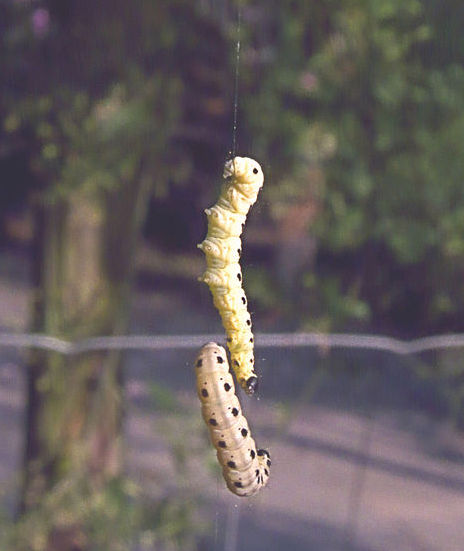
![Buff-tip Phalera bucephala Photo: By Ben Sale from UK - [1994] , CC BY 2.0, https://commons.wikimedia.org/w/index.php?curid=63708296](images/1024px-(1994)_Buff-tip_(Phalera_bucephala)_(34924490041).jpg)
Moths with gregarious larvae
Some moths have caterpillars that stay together and feed as a family group throughout all or most of the larval period. Many cover their feeding area with silk webbing. Some sawflies, which are insects in the order Hymenoptera have caterpillar-like larvae that feed gregariously. Most sawfly larvae do not web their food plant and they have seven pairs of suckers or prolegs on their abdomen, whereas moth larvae have up to five pairs of prolegs. Be aware also that the small tortoiseshell butterfly Aglais urticae also has gregarious larvae on nettle.
Species in Britain and Ireland
Larger moths with gregarious larvae that are likely to be found on garden plants in Britain and Ireland include buff-tip moth, Phalera bucephala, lackey moth, Malacosoma neustria (when young), and brown-tail moth, Euproctis chrysorrhoea. All of these have caterpillars that feed on various deciduous trees and shrubs.


![The Lackey Malacosoma neustria Photo: By Ben Sale from UK - [1634] , CC BY 2.0, https://commons.wikimedia.org/w/index.php?curid=63707568](images/(1634)_The_Lackey_(Malacosoma_neustria)_(28267552721).jpg)
Buff-tip moth, Phalera bucephala adult - camouflaged as a broken twig. Right: gregarious caterpillars
Lackey moth, Malacosoma neustria. Well camouflaged adult and gregarious caterpillars on willow
.jpg)
The day-flying cinnabar moth Tyria jacobaeae has extremely distinctive warning-coloured caterpillars which feed on ragwort Senecio jacobaea and are often found feeding in loose groups .


Two non-native species that have recently become established in Britain are the box moth, Diaphania perspectalis on box Buxus sempervirens and oak processionary moth, Thaumetopoea processionea, on oak, both of which are causing considerable concern. Caterpillars of the brown-tail moth and oak processionary moth have hairy bodies. The hairs readily break off and can cause a severe irritating skin rash on people through contact with the caterpillars, or from hairs carried on the wind. When oak processionary larvae leave their daytime shelters to feed on oak foliage, they follow each other head to tail, hence the ‘processionary’ name.


Box moth, Diaphania perspectalis caterpillar and communal defoliation effect


Oak processionary moth Thaumetopoea processionea, single caterpillar and several hundred "processing" on oak trunk.
Among the micro-moths with gregarious larvae are hawthorn webber, Scythropia crataegellam, on hawthorn and Cotoneaster horizontalis; porphyry knothorn moth, Trachycera suavella, on Cotoneaster horizontalis; and small ermine moths, Yponomeuta species on Euonymus, apple, Sedum and some Prunus species.




Above: communal web of many thousand spindle ermine caterpillars Yponomeuta cagnagella on roadside hawthorn, and two disturbed caterpillars, each hanging from a single silk thread.
Biology
After hatching, the larvae of these moths do not disperse but stay together and feed on foliage as a group. With the exception of the buff-tip and cinnabar moths, the larvae of these moths all spin silk webbing over their feeding area or create communal silk ‘nests’ in which they shelter when not feeding. Because the larvae feed together and may occur in large numbers, they are capable of defoliating small trees and shrubs.
Life cycle
Eggs are laid on the foliage or stems of plants that will provide suitable food for the larvae. After hatching the caterpillars feed on the foliage. When fully fed, the caterpillars either spin silk cocoons within the silk webbing on the food plant or they wander away from their food plants and go down into the soil where they pupate. During the pupal or chrysalis stage, the caterpillar’s tissues are broken down and rebuilt to produce the adult moth.
Some moths with gregarious larvae, such as box moth, hawthorn webber and some small ermine moths can have two generations a year. Depending on the species, these moths can overwinter as eggs, larvae or pupae.
Role of moths with gregarious larvae in gardens
The defoliation caused by gregarious moth larvae can be extensive but affected plants usually survive as long as this does not occur too frequently. Defoliation that occurs in late summer is of less consequence that similar damage in late spring-early summer.
Brown-tail moth and oak processionary moth are a problem in gardens because of the rash-inducing hairs on the caterpillars’ bodies. Other moths with hairy caterpillars can be found in gardens but they do not cause skin rashes. Hairy caterpillars and those that live within silk webbing are generally not eaten by birds, although they are attacked by various parasitic insects.
Other sources of information
Websites
Moth website of Butterfly Conservation
Website of UK Moths
Books
Goater, B. (1986) British Pyralid Moths. Harley Books
Porter, J. (2010) Colour Identification Guide to the Caterpillars of the British Isles. Apollo Books
Skinner, B. (2009) Colour Identification Guide to the Moths of the British Isles. Apollo Books
Sterling, P., Parsons, M. and Lewington R. (2018) Field Guide to the Micro-moths of Great Britain and Ireland. British Wildlife Publications
Sterling, P., Henwood, B., Lewington, R. (2020) Field Guide to the Caterpillars of Great Britain and Ireland
Bloomsbury Wildlife Guides
Townsend, M. Waring, P. and Lewington R. (2018) Concise Guide to the Moths of Great Britain and Ireland. British Wildlife Publication
Page drafted by Andrew Halstead reviewed by Andrew Salisbury edited by Steve Head












